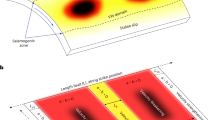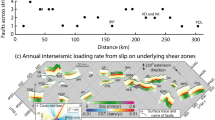Abstract
Faults that are fully or partially locked pose the greatest seismic hazard because they accumulate stress that can then be released in large earthquakes. In contrast, other faults continuously creep. The creeping versus locked behaviour is probably related to the frictional properties of the fault and the effective normal stress on the fault, but it is unclear whether locked faults are weaker or stronger than creeping faults. Here we use stress orientations in subduction zones from inversion of earthquake moment tensors, and find that geodetically determined creeping versus locked behaviour is correlated with the orientation of the subduction zone plate boundary fault relative to the principal stress axes. Globally, locked subduction zones appear well-oriented for failure, assuming a typical laboratory friction coefficient. Creeping subduction zones are more poorly oriented, implying a lower apparent friction coefficient, due to either low intrinsic friction or reduced effective normal stress. The spatial variations of stress orientation on the Japan Trench are similarly correlated with spatial variations in coupling, with creeping regions having a lower apparent friction coefficient than locked regions. The absolute strength of faults is influenced by the ambient fluid pressure, which is often elevated in subduction zones. This suggests low overall strength for locked subduction zone faults, and additional strength reduction in creeping zones that may be due to transient elevated fluid pressures.
This is a preview of subscription content, access via your institution
Access options
Access Nature and 54 other Nature Portfolio journals
Get Nature+, our best-value online-access subscription
$29.99 / 30 days
cancel any time
Subscribe to this journal
Receive 12 print issues and online access
$259.00 per year
only $21.58 per issue
Buy this article
- Purchase on Springer Link
- Instant access to full article PDF
Prices may be subject to local taxes which are calculated during checkout




Similar content being viewed by others
References
Scholz, C. H. Earthquakes and friction laws. Nature 391, 37–42 (1998).
Wang, K. & Bilek, S. L. Do subducting seamounts generate or stop large earthquakes? Geology 39, 819–822 (2011).
Scholz, C. H. & Campos, J. On the mechanism of seismic decoupling and back arc spreading at subduction zone. J. Geophys. Res. 100, 22103–22115 (1995).
Ikari, M. J., Marone, C. & Saffer, D. M. On the relation between fault strength and frictional stability. Geology 39, 83–86 (2011).
Gao, X. & Wang, K. Strength of stick-slip and creeping subduction megathrusts from heat flow observations. Science 345, 1038–1041 (2014).
Byerlee, J. D. Friction of rocks. Pure Appl. Geophys. 116, 615–626 (1978).
Hardebeck, J. L. Stress orientations in subduction zones and the strength of subduction megathrust faults. Science 349, 1213–1216 (2015).
Loveless, J. P. & Meade, B. J. Geodetic imaging of plate motions, slip rates, and partitioning of deformation in Japan. J. Geophys. Res. 115, B02410 (2010).
Loveless, J. P. & Meade, B. J. Two decades of spatiotemporal variations in subduction zone coupling offshore Japan. Earth Planet. Sci. Lett. 436, 19–30 (2016).
Scholz, C. H. & Campos, J. The seismic coupling of subduction zones revisited. J. Geophys. Res. 117, B05310 (2012).
Zhao, D., Hasegawa, A. & Kanamori, H. Deep structure of Japan subduction zone as derived from local, regional, and teleseismic events. J. Geophys. Res. 99, 22313–22329 (1994).
Hill, D. P. A note on ambient pore pressure, fault-confined pore pressure, and apparent friction. Bull. Seism. Soc. Am. 83, 583–586 (1993).
Hasegawa, A., Yoshida, K. & Okada, T. Nearly complete stress drop in the 2011 M w 9.0 off the Pacific coast of Tohoku earthquake. Earth Planets Space 63, 703–707 (2011).
Hardebeck, J. L. Coseismic and postseismic stress rotations due to great subduction zone earthquakes. Geophys. Res. Lett. 39, L21313 (2012).
Lamb, S. Shear stresses on megathrusts: Implications for mountain building behind subduction zones. J. Geophys. Res. 111, B07401 (2006).
Seno, T. Determination of the pore fluid pressure ratio at seismogenic megathrusts in subduction zones: Implications for strength of asperities and Andean-type mountain building. J. Geophys. Res. 114, B05405 (2009).
Suppe, J. Absolute fault and crustal strength from wedge tapers. Geology 35, 1127–1130 (2007).
Huang, Z., Zhao, D. & Wang, L. Seismic heterogeneity and anisotropy of the Honshu arc from the Japan Trench to the Japan Sea. Geophys. J. Int. 184, 1428–1444 (2011).
Shelly, D. R., Beroza, G. C., Ide, S. & Nakamula, S. Low-frequency earthquakes in Shikoku, Japan, and their relationship to episodic tremor and slip. Nature 442, 188–191 (2006).
Saffer, D. M. & Tobin, H. J. Hydrogeology and mechanics of subduction zone forearcs: Fluid flow and pore pressure. Ann. Rev. Earth Planet. Sci. 39, 157–186 (2011).
Rice, J. R. Heating and weakening of faults during earthquake slip. J. Geophys. Res. 111, B05311 (2006).
Fulton, P. M. et al. Low coseismic friction on the Tohoku-Oki fault determined from temperature measurements. Science 342, 1214–1217 (2013).
Harris, R. A. Large earthquakes and creeping faults. Rev. Geophys. 55, 169–198 (2017).
Mavrommatis, A. P., Segall, P., Uchida, N. & Johnson, K. M. Long-term acceleration of aseismic slip preceding the Mw 9 Tohoku-oki earthquake: Constraints from repeating earthquakes. Geophys. Res. Lett. 42, 9717–9725 (2015).
Bekins, B. A., McCaffrey, A. M. & Dreiss, S. J. Episodic and constant flow models for the origin of low-chloride waters in a modern accretionary complex. Water Resources Res. 31, 3205–3215 (1995).
Saffer, D. M. & Bekins, B. A. Fluid budgets at convergent plate margins: Implications for the extent and duration of fault-zone dilation. Geology 27, 1095–1098 (1999).
Sibson, R. H. Stress switching in subduction forearcs: implications for overpressure containment and strength cycling on megathrusts. Tectonophysics 600, 142–152 (2013).
McCaffrey, R. Statistical significance of the seismic coupling coefficient. Bull. Seism. Soc. Am. 87, 1069–1073 (1997).
Hayes, G. P., Wald, D. J. & Johnson, R. L. Slab1.0: A three-dimensional model of global subduction zone geometries. J. Geophys. Res. 117, B01302 (2012).
Kubo, A., Fukuyama, E., Kawai, H. & Nonomura, K. NIED seismic moment tensor catalogue for regional earthquakes around Japan: quality test and application. Tectonophysics 356, 23–48 (2002).
Ekström, G., Nettles, M. & Dziewonski, A. M. The Global CMT Project 2004–2010: Centroid-moment tensors for 13,017 earthquakes. Phys. Earth Planet. Inter. 200–201, 1–9 (2012).
Hardebeck, J. L. & Michael, A. J. Damped regional-scale stress inversions: Methodology and examples for southern California and the Coalinga aftershock sequence. J. Geophys. Res. 111, B11310 (2006).
Vavryčuk, V. Iterative joint inversion for stress and fault orientations from focal mechanisms. Geophys. J. Int. 199, 69–77 (2014).
Michael, A. J. Spatial variations in stress within the 1987 Whittier Narrows, California, aftershock sequence: New techniques and results. J. Geophys. Res. 96, 6303–6320 (1991).
Frohlich, C. & Davis, S. D. How well constrained are well-constrained T, B, and P axes in moment tensor catalogs? J. Geophys. Res. 104, 4901–4910 (1999).
Meade, B. J. & Loveless, J. P. Block modeling with connected fault network geometries and a linear elastic coupling estimator in spherical coordinates. Bull. Seism. Soc. Am. 99, 3124–3139 (2009).
Hashimoto, C., Noda, A., Sagiya, T. & Matsu’ura, M. Interplate seismogenic zones along the Kuril–Japan trench inferred from GPS data inversion. Nat. Geosci. 2, 141–144 (2009).
Liu, Z. et al. Integration of transient strain events with models of plate coupling and areas of great earthquakes in southwest Japan. Geophys. J. Int. 181, 1292–1312 (2010).
Nishimura, T. et al. Temporal change of interplate coupling in northeastern Japan during 1995–2002 estimated from continuous GPS observations. Geophys. J. Int. 157, 901–916 (2004).
Yokota, Y., Ishikawa, T., Watanabe, S. I., Tashiro, T. & Asada, A. Seafloor geodetic constraints on interplate coupling of the Nankai Trough megathrust zone. Nature 534, 374–377 (2016).
Uchida, N. & Matsuzawa, T. Pre-and postseismic slow slip surrounding the 2011 Tohoku-oki earthquake rupture. Earth Planet. Sci. Lett. 374, 81–91 (2013).
Sato, M. et al. Displacement above the hypocenter of the 2011 Tohoku-Oki earthquake. Science 332, 1395–1395 (2011).
Sato, M. et al. Interplate coupling off northeastern Japan before the 2011 Tohoku-oki earthquake, inferred from seafloor geodetic data. J. Geophys. Res. 118, 3860–3869 (2013).
Araki, E. et al. Recurring and triggered slow-slip events near the trench at the Nankai Trough subduction megathrust. Science 356, 1157–1160 (2017).
Meade, B. J. Algorithms for the calculation of exact displacements, strains, and stresses for triangular dislocation elements in a uniform elastic half space. Comput. Geosci. 33, 1064–1075 (2007).
Obara, K. & Hirose, H. Non-volcanic deep low-frequency tremors accompanying slow slips in the southwest Japan subduction zone. Tectonophysics 417, 33–51 (2006).
Acknowledgements
We are grateful to F. Pollitz, B. Bekins and R. Bürgmann for their constructive reviews of the manuscript. We thank the Global CMT Project and the NIED for making their earthquake moment tensor catalogues available, and G. Hayes for providing the Slab 1.0 model.
Author information
Authors and Affiliations
Contributions
J.L.H. inverted moment tensors for stress orientation and performed the model comparisons. J.P.L. computed the coupling models and the stress field from the coupling models. J.L.H. and J.P.L. interpreted the results and prepared the manuscript.
Corresponding author
Ethics declarations
Competing interests
The authors declare no competing financial interests.
Additional information
Publisher’s note: Springer Nature remains neutral with regard to jurisdictional claims in published maps and institutional affiliations.
Supplementary information
Supplementary Information
Supplementary Figures and Tables.
Rights and permissions
About this article
Cite this article
Hardebeck, J.L., Loveless, J.P. Creeping subduction zones are weaker than locked subduction zones. Nature Geosci 11, 60–64 (2018). https://doi.org/10.1038/s41561-017-0032-1
Received:
Accepted:
Published:
Issue Date:
DOI: https://doi.org/10.1038/s41561-017-0032-1



